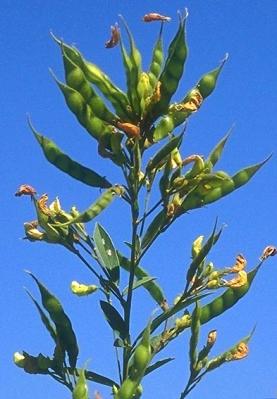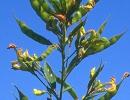
|
Pigeon pea
Scientific name:
Cajanus cajan
Order/Family:
Fabales: Fabaceae
Local names:
Swahili: Mbaazi
Pests and Diseases:
Aphids
Blister beetles
Bugs
Cercospora leaf spot
Cowpea seed beetle
Cutworms
Fusarium wilt
Jassids
Macrophomina stem canker
Phytophthora blight
Pod borers
Pod fly
Pod weevil
Powdery mildew
Purple witchweed
Root-knot nematodes
Rust
Spider mites
Termites
Thrips
Whiteflies
Purple witchweed
|
Aphids
Several species of aphids have been reported feeding on pigeon pea. The black legume aphid (Aphis craccivora) is the most common.
- Aphids seldom are a problem on pigeon pea, probably due to the effect of natural enemies.
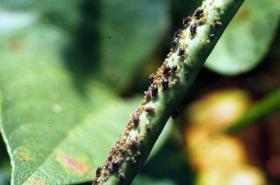
© David Riley, University of Georgia, Bugwood.org
Blister beetles (Coryna spp. and Mylabris spp.)
Adults feed on the flowers and reduce the number of pods that are set. In location where pigeon pea is grown over large areas blister beetles cause little damage. However, in small pigeon pea plots that are in the flowering stage during the period of peak adult activity, most of the flowers may be eaten by the beetles and crop losses maybe substantial. The adults are medium to large sized beetles (2 to 5 cm in length), usually black and yellow or black and red in colour. The immature stages (larvae) do not feed on plants. They live in the soil and eat grasshopper eggs, and are therefore beneficial.
- The adult beetles can be hand picked and destroyed. However, care should be taken, since when disturbed, they can release a liquid that burns the skin.
- Whenever possible wear gloves to protect the hands. Many types of essential oils extracted from eucalyptus and aromatic herbs can have repellent effects (caution: phytotoxic side effects are possible).
- In addition, rock powder or clay powder (kaolin) could have a repellent effect on these beetles. Since the larvae are beneficial, the aim should not be to destroy all adults, but to keep the numbers in check.
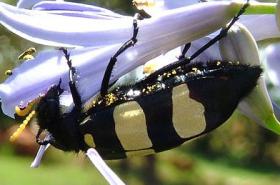
© Courtesy EcoPort (http://www.ecoport.org): A.D. Botha
Bugs
Pod sucking bugs are primary pests of pigeon peas.
The most common pod-sucking bugs are: giant coreid bugs (Anoplocnemis spp), spiny brown bugs (Clavigralla spp), Riptortus bugs (Riptortus spp) and green stink bugs (Nezara viridula).
These bugs suck developing seeds through the pod wall. The seeds become shrivelled with dark patches. Attacked seeds do not germinate and are not acceptable as food. Fungal spores are sometimes transmitted with the mouthparts during feeding, resulting in rotting of the seeds.
The spiny brown bug Clavigralla tomentosicollis is one of the most important pests of pigeon peas in Eastern Africa.
Sucking bug adults are difficult to control since they are very mobile and can invade crops from neighbouring sites.
- Immature bugs can be handpicked and destroyed.
- Adults can be collected with insect nets and destroyed.
- The main natural enemies of bugs are egg parasitoids, assassin bugs, ants and birds.
- Spraying with aromatic plants (e.g. gums, lantana, khaki weed etc.) has been suggested to repel bugs (Elwell and Mass, 1995).
- Neem-based pesticides reportedly reduce feeding by green shield bugs. For more information on neem click here.
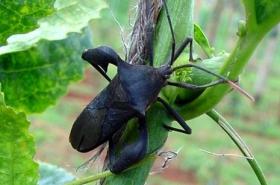
© A.M. Varela, icipe

Tip wilter…

Spiny brow…

Riptortus …

Green stin…
Cercospora leaf spot (Mycovellosiella cajani)
Small circular necrotic spots (lesions) usually appear on older leaves. These spots join up causing leaf blight and leaf drop. The African isolates of the fungus produce concentric areas on the leaf spots. The disease causes severe losses when defoliation occurs before flowering and podding. The disease usually appears when plants are flowering and podding. The fungus is seed-borne. It is favoured by cool temperatures (25º C) and humid rainy weather. The disease is more common in the long-duration and perennial varieties in Eastern Africa.
- Plant resistant varieties / lines, if available.
- Use disease-free seeds.
- Plant in fields away from perennial varieties, which could be a source of inoculums (infection).
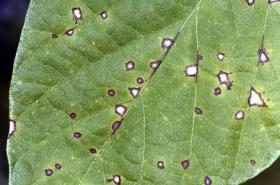
© Courtesy EcoPort (http://www.ecoport.org): Clemson University, USDA
Cowpea seed beetle
They are the most common and widespread insect pests in storage. Adults are 2-3.5 mm long. They attack both pods in the field and seeds in storage. They attack nearly mature and dried pods. Infested stored seeds can be recognised by the round exit holes and the white eggs on the seed surface. Post-harvest losses are highly variable, but losses can be over 90%.
- Pods should be harvested as soon as they mature and the seeds sun dried before stored in clean beetle-proof containers.
- A coating of edible oils or of inert clay can prevent further development of bruchids in the stored seeds.
- Some farmers in East Africa use wood ash in grain stored for food or seed for planting, or chillies or smoke from cooking fire to preserve seeds for planting.
- Other farmers store unthreshed pods as a strategy to minimise grain damage by bruchids (Minja et al. 1999).
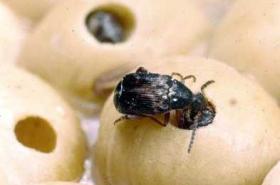
© Clemson University - USDA Cooperative Extension Slide Series, www.insectimages.org
Fusarium wilt (Fusarium udum)
It is a fungal disease. Symptoms include partial or total wilting of plants at flowering and podding, a purple band of stems extending from the base upwards, browning of the stem tissue in the purple band area, and browning or blackening of internal tissue when the main stem or primary branches are split. Infected young plants may not show the purple band symptom but have conspicuous internal browning and blackening. Affected fields show patches of dead plants. F. udum is seed and soil-borne. The fungus survives on infected crop debris in the soil for about 3 years.
Crop rotation is advisable against diseases such as Fusarium wilt. Pigeon pea is generally grown in inter- and mixed-cropping systems in rotation with other crops, particularly cereals. However, since the fungus-causing agent of wilt of pigeon pea survives on deep-seated roots of the host, the success of rotation will depend upon the field sanitation (removal of affected plants with their roots). A 4-5-year rotation has been found to free the field completely of the wilt pathogen (causing fungal agent). However, in smallholder scenarios this is not practical due to land restriction. One-year breaks with either sorghum or fallow reduced wilt in the following pigeon pea crop from more than 50 to below 20%.
Pigeon pea rotation with tobacco has been recommended as a possible means of control because of the adverse effect of tobacco root exudates on the pathogen. For more information on Fusarium wilt click here.
- Plant of resistant varieties / lines. For instance, the long duration varieties (cultivar) "ICP9145" and "ICEAP00040" are resistant to Fusarium wilt and have superior productivity on-farm (Snapp et al, 2003).
- Use certified disease-free seeds.
- Plant in fields with no previous record of wilt for at least 3 years
- Uproot wilted plants (and use them for fuel wood).
- Collect and burn plant residues after harvesting.
- Crop rotation with cereals.
- Soil amendment with Trichoderma products. These are commercially available in Kenya.
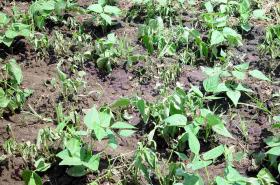
© A.M. Varela, icipe
Leafhoppers or Jassids (Jacobiasca lybica)
Jassids (leafhoppers) have been reported to cause damage to pigeon peas in Kenya. These small (2.5 mm) green and very mobile insects occur on the upper and lower leaf surface. The adults fly or hop away when disturbed. Nymphs resemble adults, but have no wings, and run sideways when disturbed. The eggs are inserted in the veins on the underside of leaflets. Adults and nymphs feed by sucking on the leaflets. Attacked leaves become cup shaped and yellow at the edges. Heavy attacks result in the leaflets turning red-brown, with subsequent defoliation and stunting.
- Use neem kernel extract and other neem products.
Neem treatments against aphids should be enough to control jassids at the same time. For more information on neem click here

© Steve L. Brown, University of Georgia, Bugwood.org
Macrophomina stem canker (Macrophomina phaseolina)
Initial symptoms on stems and branches are spindle-shaped spots with light grey centres surrounded by brown margins. The centres of the spots have scattered dots (pycnidial bodies - fungal spores). The spots may join up and cause the branches or whole plants to dry up and die. Diseased plants suddenly wilt. When diseased plants are uprooted their roots are rotten and shredded. The fungus mainly attacks secondary finer roots. These roots have dark, blackened streaks underneath their barks with dots (pycnidial bodies - fungal spores). The disease could be a serious problem in late-sown and in perennial or rationed pigeon peas. Disease development is favoured by hot dry weather (30º C). Crops are more susceptible to the disease in the reproductive than in the vegetative stage.
- Plant resistant varieties / lines, if available.
- Plant in fields with no previous history of the disease.
- Avoid late planting.
- Rotate with cereals and fodder grasses.
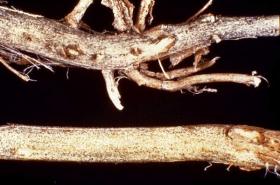
© D. C. McGee/Iowa State University (Reproduced from CABI 2006)\n
Phytophthora blight (Phytophthora dreschsleri f.sp. cajani)
The disease causes sudden death of seedlings. Infected leaves have water-soaked spots that turn brown to black. Infected leaves lose turgidity and finally become desiccated. On stems and leaf petioles the spots are slightly sunken. Affected stems or branches are girdled and foliage above dries up. Plants that are attacked but not killed often form large galls on their stems especially at the edges of spots. The fungus does not infect the root system. The fungus is soil-borne and it also survives on infected crop debris. The disease is favoured by cool temperatures around 25º C, cloudy humid weather and rain. Plants develop tolerance to the disease with age.
- Plant resistant varieties / lines, if available,
- Plant in fields with no previous record of blight,
- Avoid fields prone to waterlogging,
- Use wide inter-row spacing.
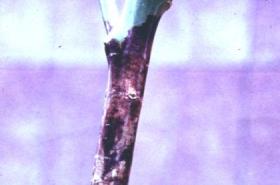
© Courtesy EcoPort (http://www.ecoport.org): Y.L. Nene
Pod borers
The African bollworm (Helicoverpa armigera), the legume pod borer (Maruca vitrata = testulalis) the lima bean pod borer (Etiella zinckenella) are major pests of pigeon peas in East Africa. They feed on leaves, flowers and pods, destroying them.
The African bollworm (Helicoverpa armigera)
Caterpillars are 1.5 to 4cm long. They bore holes on pods and feed on the seeds. Usually developing in the pods and feeding partly mature seeds.
For more information on the African bollworm click here.
The legume pod borer (Maruca vitrata)
The adult of the legume pod borer is a moth with a wing span of 15-30 mm. It has light-brown forewings with white markings and pearly white hindwings. Though mainly nocturnal, the moth may also be seen during the day. They lay eggs in the flowers or buds, or on the pods. Caterpillars are whitish with black head and rows of conspicuous brown to black spots on the dorsal, lateral, and ventral surfaces of each body segment. Fully-grown caterpillars measure about 15mm in length. They pupate in the soil. Caterpillars web leaves, flower buds and pods and feed inside the web. Flowers usually show little sign of damage until they wilt and drop. They typically attack pods at the point of contact between two pods, or between a pod and a leaf or stem.
The lima bean pod borer
Adults of the lima bean pod borer are brown moths with a wing span of about 20-25 mm. They lay eggs singly or in small groups on immature pods. Young caterpillars bore into the pod. They feed inside the pod reaching a length of 12 to 17 mm and are generally found in maturing and dried pods. Young caterpillars are green, turning red later. Faeces in the form of granules are found inside the damaging pods.
- Apply biopesticides such as Bt or neem products. They usually give good control of pod borers, provided they are applied to pods before the young caterpillars enter into the pods. Once the caterpillars have entered the pods they are difficult to control and by then they have caused damage. Other plant derivatives reported to control pod borers are tephrosia and chilli/garlic. For more information on Bt click here. For more information on neem click here
- Monitor regularly the crop to detect eggs and young caterpillars before they enter the pods
- Conserve natural enemies. Ants, parasitic wasps and pirate bugs are important in natural control. Bird perches placed just above the crop canopy are also reported to reduce the numbers of pod borers
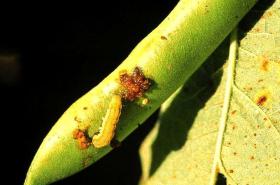
© A.M. Varela, icipe

African bo…

Legume pod…

Lima bean …
The pod fly (Melanagromyza chalcosoma)
It is a small black fly that lays eggs through the walls of developing pods. The maggots (white in colour and about 3 mm long) feed inside the green seed. The brown barrel shaped pupa is formed inside the pod but outside the seed.
There are no obvious external symptoms of attack till the fully-grown maggot chews holes in the pod walls leaving a window through which the flies emerge after pupation in the pod. Damaged seeds are of no value. The pod fly causes most damage on pigeon pea maturing during cool weather and pigeon pea planted at altitudes higher than 500 m above sea level.
- In areas where the pod fly is a problem, it is best to avoid growing a mixture of cultivars of differing duration in one area because this will provide pods over a long period and allow several generations of the pod fly to develop.
- Neem has given control of a related pod fly (M. obtusa) on pigeon pea in India. Four weekly applications of aqueous neem seed extract (ANSE) 50g/l and fortnightly sprays of aqueous neem kernel extract (ANKE) 80g/l have given effective control (Ostermann and Dreyer, 1995). For more information on neem click here.
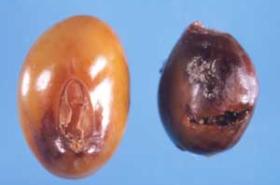
© Jeffrey Lotz, Florida Department of Agriculture and Consumer Services.
The pod weevil (Apion clavipes)
It has been regarded as a major pest of pigeon pea in East Africa. Adults are small black weevils. The larvae are creamy white. Larvae damage the green seeds in pods but the damage is usually noticed only after adults emerge cutting the way out of the pod. The beetles also chew small holes in leaflets and flowers.
- Use neem extracts. Research in India has shown some efficacy of neem extracts against this pod weevil. For more information on neem click here.
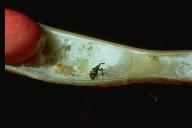
© Frank Peairs, Colorado State University
Powdery mildew
The disease can infect all aerial parts: leaves, flowers and pods. Characteristic of the disease is white greyish powdery fungal growth on affected plant parts. Small chlorotic spots develop on the upper surface of leaves and the corresponding lower surface develops white greyish powdery fungal growth. With time the powdery growth covers the entire lower leaf area. Severe infection causes heavy leaf drop. The fungus develops at temperatures ranging from 20 to 35º C, but 25º C is the optimum. The fungus survives on perennial pigeon peas and volunteer plants, and on the ratoon growth of the harvested plants. Plants with thicker leaves, as most varieties in Kenya are more tolerant to the disease than those with thin succulent leaves (Indian varieties).
- Plant resistant varieties / lines, if available.
- Plant in fields away from perennial pigeon peas.
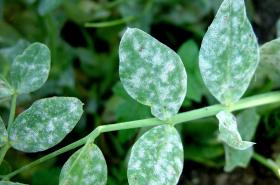
© A.M. Varela, icipe

Powdery mi…

Powdery mi…
Root-knot nematodes (Meloidogyne incognita, M. javanica)
Affected plants are normally stunted and eventually wilt and die. The most characteristic symptom is formation of root galls (knots) and these can be seen with the naked eye. Affected roots rot.
- Plant resistant varieties / lines, if available.
- Plant in fields with no previous record of nematode infestation.
- Rotate with cereals.
- Amend soil with neem extracts.
- A number of bio-products for control of nematodes are going through registration process in Kenya. For more information on nematodes click here
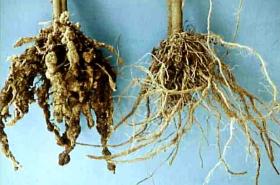
© A. M. Varela, icipe
Rust (Uredo cajani)
Symptoms appear as dark brown raised spots full of brown spores (uredia) on the lower leaf surfaces. Infected leaves dry and drop off. When disease is severe, it causes extensive defoliation. The disease is favoured by rain and wind that facilitate spore release, dispersal and development.
- Plant resistant varieties / lines, if available.
- Avoid planting of pigeon peas close to bean fields.
- Avoid dense planting.
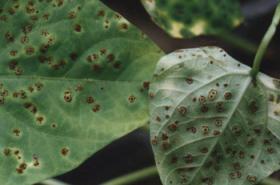
© Courtesy EcoPort (http://www.ecoport.org): Dongxin Feng,
Red spider mites (Tetranychus spp.)
Red spider mites are about 0.6 mm long. They feed on the lower leaf surface causing white or yellowish spots on the upper leaf surface. Heavy infestation results in partial defoliation.
- Red spider mite attack is seldom severe enough to merit control.
- Use resistant cultivars. Most widely used cultivars appear to be relatively resistant to these mites.
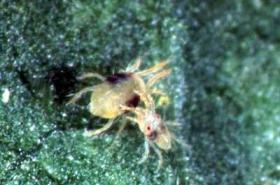
© Warwick HRI, University of Warwick.
Thrips (Megalurothrips spp. and Frankliniella schultzei)
Thrips are small (1.5 mm long), slender, brown insects with pale yellow hind wings that appear as a yellow line down the back of the body when the insect is at rest. Adult thrips have characteristic wings; the transparent wings have a fringe of hairs around the outside edge standing out in the same plane as the wing.
Several species of thrips are common on pigeon peas in Eastern Africa and are considered important pests. These thrips feed on leaves and flowers. Main damage is due to thrips feeding on flower buds and flowers. Heavy infestation can lead to shedding of buds and flowers. However, according to reports from India, pigeonpea plants produce more flowers than the plant can sustain, so many are lost naturally and it is difficult to assess thrips damage (Ikisan, 2000).
- Conserve natural enemies. Predatory mites and pirate bugs are important for the natural control of thrips. For more information on natural enemies click here
- Monitor the crop regularly. Early detection is particularly important at the onset of flowering.
- Whenever necessary spot spray the crop with botanicals. Some plant extracts (e.g. garlic, rotenone, neem, pyrethrum and a mixture of garlic and pepper etc.) are reported to control thrips. Spinosad, a bacterial derivative, is effective in controlling thrips.
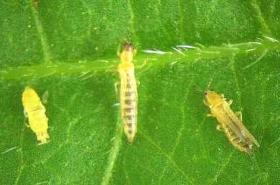
© M. Billah, icipe
| General Information and Agronomic Aspects | Information on Diseases | |||
| Information on Pests | Information Source Links |
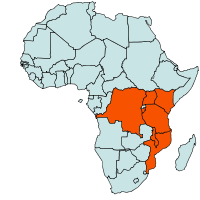 |
| Geographical Distribution of Pigeon pea in Africa |
Pigeon pea is a perennial shrub that is commonly grown as an annual crop. It has very slow initial development (up to 2 months after planting). With a deep taproot, pigeon peas are able to take up nutrients and water from lower subsoil layers. Therefore, in crop mixes they hardly compete with the companion crops. This crop grows and yields well under conditions of low rainfall and poor soil.
Pigeon pea is well balanced nutritionally and an excellent source of protein. It is eaten as a vegetable (immature pods or green pea) or as dried grain (cooked and eaten as dhal, dry split cotyledons). The crop has many other uses: the wood is used as fuel, and the leaves and husks provide livestock feed.
Pigeon pea is useful as tall hedges on dry soil and on the bunds of paddy fields. The branches and stems can be used for baskets and firewood. It is often grown as a shade crop, cover crop or windbreak. After establishment, pigeon pea improves the soil by its extensive root system. The bacterium Rhizobium that lives on the roots of the pigeon pea is able to fix nitrogen and thus to improve soil fertility. Fallen leaves are used as mulch. Traditional uses as medicine are many, e.g. young leaves are applied to sores, herpes and itches.
Nutritive Value per 100 g of edible Portion
| Raw or Cooked Pigeon Pea | Food Energy (Calories / %Daily Value*) |
Carbohydrates (g / %DV) |
Fat (g / %DV) |
Protein (g / %DV) |
Calcium (g / %DV) |
Phosphorus (mg / %DV) |
Iron (mg / %DV) |
Potassium (mg / %DV) |
Vitamin A (I.U) |
Vitamin C (I.U) |
Vitamin B 6 (I.U) |
Vitamin B 12 (I.U) |
Thiamine (mg / %DV) |
Riboflavin (mg / %DV) |
Ash (g / %DV) |
| Pigeon Peas (Red Gram) cooked | 121 / 6% | 23.2 / 8% | 0.4 / 1% | 6.8 / 14% | 43.0 / 4% | 119.0 / 12% | 1.1 / 6% | 384 / 11% | 3.0 IU / 0% | 0.0 / 0% | 0.1 / 3% | 0.0 / 0% | 0.1 / 10% | 0.0 / 0% | 1.1 |
| Pigeon Peas (Red Gram) raw | 343 / 17% | 62.8 / 21% | 1.5 / 2% | 21.7 / 43% | 130 / 13% | 367 / 37% | 5.2 / 29% | 1392 / 40% | 28.0 IU / 1% | 0.0 / 0% | 0.3 / 14% | 0.0 / 0% | 0.6 / 43% | 0.2 / 11% | 3.5 |
| Variety | Maturity period (days) | Potential yield (90kg bags/acre) | Characteristics |
| "Kat 60/8" | 135-150 | 5-7 for one season (13 for 2 seasons) | Grains are white with brown spots and smaller seed size than local races. Grows between 0-1800 m above sea level and performs well where temperatures are high. Tolerant to Fusarium wilt and leaf spot diseases. Susceptible to pod sucking bugs and pod borers. |
| "Kat 81/3/3" | 170-185 | 6-11 | Tolerant to wilt, pod sucking bugs and pod borers. Cream white grain with large brown patches. Adapted to medium and higher altitudes (over 900 m above sea level) |
| "Kat 777" | 160-180 | 6-10 | Oval white seeds. Adapted to medium and higher altitudes (above 900 m above sea level) |
| "ICPL 89091" | 120 | 4 for one season, 8 for 2 seasons | It is grown in the same range of altitude as "KAT 60/82" but is more adapted to the more humid coastal zones. Performs best in pure stands at quite high density. |
| "Mbaazi-1" | 105-120 | 4 in one season | Grows between 600 and 900 m above sea level. Grain greyish in colour. Should be grown as a pure stand |
| "Mbaazi-2" | 150-180 | 6 | Adapted to medium and high altitudes (900 - 1800 m). Grain greyish in colour. Tolerant to insect pests and Fusarium wilt |
| "Mbaazi-3" | 90-105 | 6 | Performs well at altitudes 10-1500 m. Grain greyish in colour |
| "Local races" |
- "Komboa" (performs well below altitude of 1500 m; early maturing about 90 - 100 days; grain mottled cream and brown; potential yield of about 4 t/ha)
- "Mali" (adapted to altitude between 500 - 1500 m; medium maturity: 130 - 150 days; grain yield 1.0 - 3.0 t/ha; resistant to Fusarium wilt; tolerant to insect pests and drought)
- "Tumia" (performs well below 1500 m altitude; recommended for areas with low to medium rainfall (250 - 600 mm); maturity less than 150 days; grain yield of 1.8 - 2.4 t/ha; white grain colour; susceptible to Fusarium wilt; tolerant to drought)
- "Luwe 1 - 5" (maturity of about 159 days; grain yield of 1.2 t/ha; white grain colour; susceptible to Fusarium wilt)
- "KAT 60/8" (as in Kenya)
- "KAT 60/8" (as in Kenya)
- "Apio Elina" (local variety; grown between 1000 - 1175 m; maturity: 6 - 9 months; grain yield: 250 - 500 kg/ha)
- "Adyang" (local variety; maturity: 6 - 9 months; yield: 250 - 450 kg/ha)
- "ICPL 87091" (maturity: 97 - 104 days; gain yield: 1.99 t/ha; white grain colour)
- "ICPL 87101" (maturity: 93 - 102 days; grain yield: 2.2 t/ha; brown grain colour)
- "ICPL 90029" (maturity: 92 - 104 days; grain yield: 1.6 - 2.5 t/ha; brown grain colour)
Propagation is by seed, stem cuttings rarely succeed. Pigeon pea varieties differ not only in form of seeds, colour and taste, but also in growth habit, time of flowering and susceptibility towards pests and diseases. Seed rate: 20-25 kg per ha (8-10 kg per acre)
Land preparation
Pigeon pea thrives best in seedbeds prepared by deep ploughing and cultivations to reduce weeds. Seeds should be sown in rows with spacing of 30-50 cm x 75-150 cm and 10cm deep. There is no standard spacing - spacing depends on variety, soil type and production system. In dry areas, and especially in coarse-textured, infertile soils, farmers use wide spacing between plants to limit competition.
Plants are fairly slow to start and weed control for the first two months is important in crop establishment. Once plants are established they grow vigorously.
Intercropping
In intercropping, the crop performs well with 2 rows of cereals (e.g. sorghum, millets), cotton or groundnut. After harvest of the intercrop, long-duration pigeon pea continues to grow and protects the soil. Pigeon pea is regarded as a good plant for restoration of fertility and is used in a rotation with crops such as maize-groundnut-tobacco-pigeon pea for three to four years in Uganda. One of the advantages of pigeon pea is the increased growth of the grass interplanted with it. In Uganda, it is usually sown in alternate rows with sesame or African finger millet (Eleusine coracana), and in Malawi with maize. In Tanzania, the main intercrop is cassava. In Kenya, sorghum and maize are the most common intercrops with pigeon pea. However, due to its high demand, there is a tendency to move away from traditional intercropping to monocropping. In Ukambani and Coastal strip, Kenya, the crop is grown commercially in large plots.
The most important pests of pigeon peas are insects feeding on pigeon pea pods and seeds. Surveys in Kenya, Malawi, Tanzania and Uganda (Minja et al., 1999) have shown that the most important pests of pigeon pea pods and seeds in the region are:
- pod sucking bugs,
- pod and seed boring caterpillars,
- pod flies
Varieties that mature during the dry season have low damage levels (Snapp et al., 2003). A number of caterpillars (e.g. hairy caterpillars and semiloopers), and beetles (e.g. weevils, and foliage beetles) that feed on foliage of other legumes and grain legumes also attack pigeon peas, but they are usually not important.
|
Leafhoppers or Jassids (Jacobiasca lybica) Jassids (leafhoppers) have been reported to cause damage to pigeon peas in Kenya. These small (2.5 mm) green and very mobile insects occur on the upper and lower leaf surface. The adults fly or hop away when disturbed. Nymphs resemble adults, but have no wings, and run sideways when disturbed. The eggs are inserted in the veins on the underside of leaflets. Adults and nymphs feed by sucking on the leaflets. Attacked leaves become cup shaped and yellow at the edges. Heavy attacks result in the leaflets turning red-brown, with subsequent defoliation and stunting. | 
Leafhopper (Jassid)
Leafhopper. Adults are small, about 2.5 mm long. Picture shows Empoasca fabae © Steve L. Brown, University of Georgia, Bugwood.org |
|
What to do:
|
|
Root-knot nematodes (Meloidogyne incognita, M. javanica) Affected plants are normally stunted and eventually wilt and die. The most characteristic symptom is formation of root galls (knots) and these can be seen with the naked eye. Affected roots rot. | 
Root-knot nematodes
Root-knot nematodes (Meloidogyne incognita, M. javanica) Roots of severely attacked (left) and healthy plant (right). Affected plants are normally stunted and eventually wilt and die. The most characteristic symptom is formation of root galls (knots) and these can be seen with the naked eye. Affected roots rot. © A. M. Varela, icipe |
|
What to do:
|
|
Thrips (Megalurothrips spp. and Frankliniella schultzei) Thrips are small (1.5 mm long), slender, brown insects with pale yellow hind wings that appear as a yellow line down the back of the body when the insect is at rest. Adult thrips have characteristic wings; the transparent wings have a fringe of hairs around the outside edge standing out in the same plane as the wing. | 
Thrips
The Western flower thrips (Frankliniella occidentalis). Close-up, immature thrips (left) and adults. Very much enlarged. Real size (0.9 to 1.1 mm) © M. Billah, icipe |
|
What to do:
|
|
Bugs Pod sucking bugs are primary pests of pigeon peas.
| 
Tip wilter
Tip wilter / giant coreid bug (Anoplocnemis curvipes) is about 2.5cm long. © A.M. Varela, icipe |
|
What to do:
|
|
Pod borers The African bollworm (Helicoverpa armigera), the legume pod borer (Maruca vitrata = testulalis) the lima bean pod borer (Etiella zinckenella) are major pests of pigeon peas in East Africa. They feed on leaves, flowers and pods, destroying them. | 
African bollworm
African bollworm (Helicoverpa armigera) damage on beans © A.M. Varela, icipe |
|
What to do:
|
|
The pod fly (Melanagromyza chalcosoma) It is a small black fly that lays eggs through the walls of developing pods. The maggots (white in colour and about 3 mm long) feed inside the green seed. The brown barrel shaped pupa is formed inside the pod but outside the seed. | 
Pod fly
Pod fly Melanagromyza chalcosoma) damage on pigeon pea © Jeffrey Lotz, Florida Department of Agriculture and Consumer Services. |
|
What to do:
|
|
The pod weevil (Apion clavipes) It has been regarded as a major pest of pigeon pea in East Africa. Adults are small black weevils. The larvae are creamy white. Larvae damage the green seeds in pods but the damage is usually noticed only after adults emerge cutting the way out of the pod. The beetles also chew small holes in leaflets and flowers. | 
Pod weevil
Pod weevil Apion species on bean pod. © Frank Peairs, Colorado State University |
|
What to do:
|
|
Fusarium wilt (Fusarium udum) It is a fungal disease. Symptoms include partial or total wilting of plants at flowering and podding, a purple band of stems extending from the base upwards, browning of the stem tissue in the purple band area, and browning or blackening of internal tissue when the main stem or primary branches are split. Infected young plants may not show the purple band symptom but have conspicuous internal browning and blackening. Affected fields show patches of dead plants. F. udum is seed and soil-borne. The fungus survives on infected crop debris in the soil for about 3 years. | 
Fusarium wilt
Fusarium wilt on beans © A.M. Varela, icipe |
|
What to do:
|
- AIC (2002). Field Crops Technical Handbook. Nairobi, Kenya
- CAB International (2005). Crop Protection Compendium, 2005 Edition. www.cabi.org Wallingford, UK
- Elwell, H., Maas, A. (1995). Natural Pest & Disease Control. Natural Farming network, Zimbabwe. The Plant Protection Improvement Programme and The Natural Farming Network.
- Food and Agriculture Organization of the United Nations www.fao.org
- Hillock, R. J., Minja, E., Mwaga, A., Silim Naddy, M., Subrahmanyam, P. (2000). Diseases and pests of pigeonpea in Eastern Africa: A review. International Journal of Pest Management. 46 (1): 7-18
- Minja, E.M., Shanower, T.G., Songa, J.M, Ong'aro, J.M., Kawonga, W.T., Mviha, P., Myaka, F.A., Slumpa, S., Okurut-Akol, H., Opiyo C. (1999). Surveys of insect pest damage and pest management practices on pigeon pea in farmers' fields in Kenya, Malawi, Tanzania and Uganda. African Crop Science Journal 7 (1): 59-69.
- Nutrition Data www.nutritiondata.com.
- OISAT, Organisatino for Non-Chemical Pest Management in the Tropics. www.oisat.org
- Oestermann, H., Dreyer, M. (1995). Vegetables and grain legumes. In "The Neem tree Azadirachta indica A. Juss. and other meliaceous plants sources of unique natural products for integrated pest management, industry and other purposes". (1995). Edited by H. Schmutterer in collaboration with K. R. S. Ascher, M. B. Isman, M. Jacobson, C. M. Ketkar, W. Kraus, H. Rembolt, and R.C. Saxena. VCH. Pp. 392-403. ISBN: 3-527-30054-6
- Red Gram. Insect Management (2000). www.ikisan.com
- Reddy, M.V., Raju, T.N., Sharma, S.B., Nene, Y.L. and McDonald, D. (1993). Handbook of pigeon pea Diseases. Information Bulletin No. 42. International Crops Research Institute for the Semi-Arid Tropics. ISBN: 92-9066-277-8.
- Reed, W., Lateef, S. S., Sithanantham and S., Pawra, C. S. (1989). Pigeon Pea and chickpea insect identification handbook. Information Bulletin no. 26. International Crops Research Institute for the Semi-Arid Tropics. ISBN: 92-9066-171-2.
- Shanower, T.G., Romeis, J., Minja, E.M. (1999). Insect pests of pigeon pea and their management. Annual Review of Entomology, Vol. 44: 77-96.
- Snapp, S. S., Jones, R. B., Minja, E. M., Rusike, J. and Silim, S. N. (2003). Pigeon pea for Africa: A versatile vegetable - and more. HortScience, Vol. 38(6). Pp 1073-1079. www.kbs.msu.edu

 Back
Back
